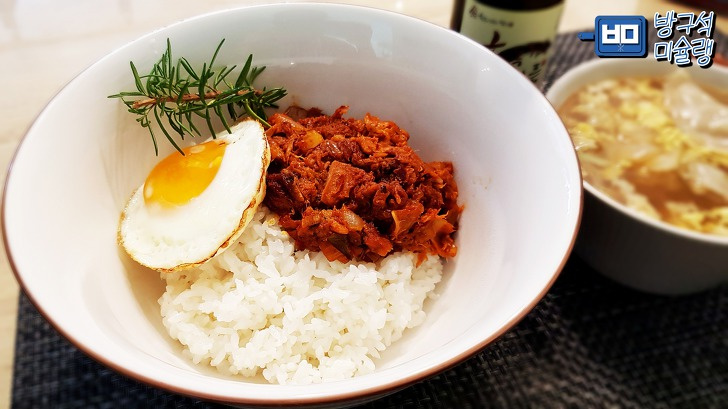Super Simple Gochujang Tuna Bibimbap
So Easy, So Delicious! How to Make Gochujang Tuna Bibimbap – A Quick Recipe

Introducing a super simple Gochujang Tuna Bibimbap recipe that you can whip up with minimal ingredients. Enjoy a fantastic meal with just basic components and an easy cooking process. This bibimbap is a true rice thief – it’ll have you clearing your plate in no time. Let’s make it right away!
Gochujang Tuna Bibimbap Golden Recipe (Serves 2)- 1 can (150g) Tuna
- 2 Tbsp Gochujang (Korean chili paste)
- 1 Tbsp Gochugaru (Korean chili flakes)
- 1 Tbsp Soy Sauce
- 2 Tbsp Oligodang (corn syrup or honey)
- 1/2 Onion
- 6 Frozen Dumplings
- 1 Tbsp Water
- 2 bowls Cooked Rice
- 2 Fried Eggs
- Sesame Oil, to taste
Cooking Instructions
Step 1
[Gochujang Tuna Bibimbap Golden Recipe (Serves 2)] [Basic Ingredients] 1 can (150g) Tuna2 Tbsp Gochujang (Korean chili paste)
1 Tbsp Gochugaru (Korean chili flakes)
1 Tbsp Soy Sauce
2 Tbsp Oligodang (corn syrup or honey)
1/2 Onion
6 Frozen Dumplings
1 Tbsp Water
2 bowls Cooked Rice
2 Fried Eggs
Sesame Oil, to taste

Step 2
First, prepare one 150g can of tuna. This single can is enough to make bibimbap for 2 to 3 servings.

Step 3
1. Peel and dice half an onion, about the size of your fist, into 1cm cubes. (Don’t worry if your onion has sprouted; it’s perfectly safe to eat!)
2. Get 6 frozen dumplings ready. Frozen dumplings contain various meats and vegetables, adding a delightful chewiness and serving as a convenient ingredient when other fresh vegetables are scarce.

Step 4
Let me introduce a handy tool for the kitchen! This adjustable dish rack can be placed over your sink, making it convenient for washing and drying dishes.

Step 5
Now, heat a frying pan over medium heat. Once the pan is warm, drain the tuna oil and pour it into the pan. Using tuna oil instead of regular cooking oil adds a deeper, richer flavor.

Step 6
Add the diced onion to the hot tuna oil in the pan over medium heat and stir-fry.

Step 7
Sauté the onions until they become translucent, release a sweet aroma, and begin to caramelize. This caramelization process develops a deeper, sweeter flavor profile.

Step 8
Once the onions are lightly golden and sautéed, reduce the heat to low. Add 2 tablespoons of gochujang and stir. Cooking gochujang over low heat prevents it from burning and helps develop its rich flavor.

Step 9
Next, add 1 tablespoon of gochugaru (Korean chili flakes) and stir-fry together. Gochugaru will enhance the color and add a pleasant spiciness to your bibimbap.

Step 10
To add a savory depth to the dish, pour in 1 tablespoon of soy sauce. Soy sauce helps harmonize the flavors of all the ingredients.

Step 11
Add the 6 frozen dumplings to enrich the texture of the dish. The dumplings will provide a satisfying chew and make the bibimbap more filling.

Step 12
Generously add 2 tablespoons of oligodang (corn syrup or honey) for sweetness and a glossy finish. Oligodang makes the bibimbap sauce smoother and tastier.

Step 13
Add the prepared 150g of tuna. Tuna is the main source of protein and brings a rich flavor to the bibimbap.

Step 14
To help the frozen dumplings break apart easily and to prevent the sugary ingredients like gochujang and oligodang from burning, add 1 tablespoon of water and mix everything well.

Step 15
Now, increase the heat to medium and begin stir-frying all the ingredients until well combined. Cook for about 1-2 minutes, allowing the flavors to meld.

Step 16
Mash the dumplings as you stir-fry them. The goal is to release the filling and mix it well with the sauce, so don’t hesitate to break them down! This ensures the dumpling filling is thoroughly incorporated into the bibimbap sauce.

Step 17
Gently place two bowls of warm cooked rice into serving bowls. Arrange them attractively, keeping in mind that toppings will be added.

Step 18
Spoon a generous amount of the well-stir-fried gochujang tuna mixture over the rice. Your appetizing and delicious bibimbap is ready!

Step 19
The finishing touch for any bibimbap is sesame oil! Drizzle about a tablespoon of sesame oil over the top. The nutty aroma of sesame oil will further enhance your appetite. Can you almost smell the deliciousness from the picture?




